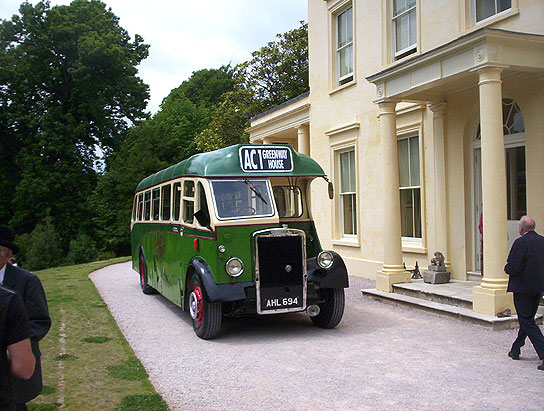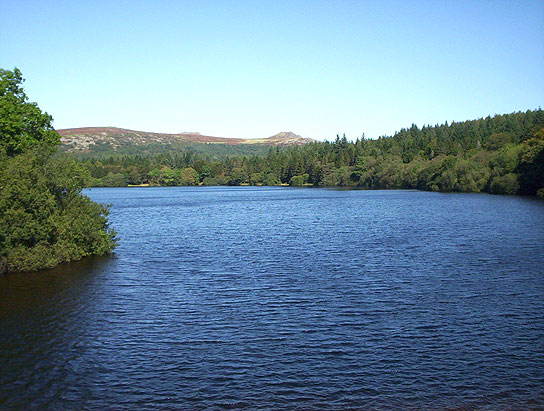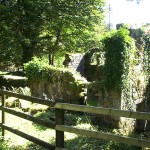The Dartmoor longhouse is a type of medieval farmhouse once common in the area. Built on a slope, they housed people and animals in the same building. The people lived in the upper end, above a cross passage, and the cows were tethered in stalls in the lower end, or shippon, with their heads to the wall, and their other end near a central gully which discharged out of the lower end of the building. Once there were hundreds of these longhouses, but while some survive as cottages or farm buildings, almost none still have an unconverted shippon.
This one was purchased by the Dartmoor National Park Authority because of its original state. The living quarters have a large fireplace, old-fashioned rooms and an upstairs where original thatch still blackened by a medieval central fireplace can be seen. Below the cross-passage, the shippon still has animal pens and central drain.
The longhouse is not regularly opened to the public, partly because of that problem that afflicts ancient settlements that collide with the 21th century, i.e. “nowhere to park”. I saw it on a Heritage Open Day, when we had to rendezvous at a moorland car park half a mile away and be ferried to the site. The visit was most interesting, and I recommend that you check out visit opportunities and make the effort to see it. There is also an online virtual tour.
Category: South-west
location
Lynton/Lynmouth, Devon
You might recall Lynmouth as the scene of a flood disaster some decades ago. Essentially, Lynton is on the clifftop and Lynmouth is down below, and the two are connected by steep roads and a famous cliff railway. Lynton is a Victorian village where it can be interesting to wander around and look at stuff. There should be fine sea views from here. You can take the water-powered railway 500ft down the cliff to Lynmouth and wander around there and look at stuff, including the harbour, and the interesting exhibition about the flood disaster of 1952.
The roads in this area are of the brake-testing variety. The A39 snakes around Lynton and the gorge in a very roundabout way with some step gradients, but if you go through Lynton, which is the way a sat-nav may direct you, you will descend to near sea-level and up again via 1 in 4 gradients.
Hartland Quay, Devon
This is a dramatic stretch of rocky coast with high cliffs, where ships used to run aground in large numbers, with much loss of life and property. Despite modern engines and navigation aids, they occasionally still do…
The land around the Quay is privately owned, and one usually has to pay a small charge to drive onto it and park. There is a parking area halfway down, if you don’t want to drive all the way down and up again. Down below is a hotel with public bar, a small museum with exhibits about wrecks, and an area of shore where the harbour used to be before it was demolished by storms. On the beach in the other direction there were some rusty bits of ship lying about.
It’s worth spending a few hours here, to look at the view, look down on any wrecks, visit the wreck museum, have a drink, and maybe paddle from the beach.
If you want more to do, in the same area are other look-out points, e.g. Hartland Point, and also the Hartland Abbey estate. There are also coastal paths.
Greenway, Devon

This is the former home of best-selling author Agatha Christie. The house is in a rural setting on the banks of the Dart estuary, and is set in extensive gardens and grounds that slope down to the riverbank. Many visitors, of course, are drawn here by the Christie connection. The house contains many interesting family collections (Christie’s husband was an archaeologist). The Georgian house dates from 1790, with early nineteenth-century additions.
There is an intriguing frieze in the library, painted by an American naval officer whern the house was requisitioned during WWII. Outside there is a stable block, and down by the river a substantial Georgian boathouse. The gardens are quite large and some time can be spent exploring them.
There are strong disincentives to arriving here by car – the roads are awful and the NT car park is very small, so visitors have to ring up and book a space well (i.e. days) in advance. I don’t remember my whole itinerary, but I arrived by minibus from a bus station in some town nearby. Apparently there is also a vintage shuttle bus service. You can also arrive by river ferry from Dartmouth etc.

Hound Tor Medieval Village, Devon
English Heritage.
This deserted medieval village comprises four thirteenth century stone farmsteads, which were probably abandoned in the 15th century. Walls survive to a height of about 3 feet, marking out the outline of various structures.
This is quite an interesting site to find and visit. You will need a detailed local map. If you park by the minor road that runs to the west, the village is more or less behind Hound Tor, so you have to climb the Tor or skirt around it till you see the remains. Distance about 1000 yards. Walking boots and stout trousers are recommended, as there may be dense vegetation in places.
Burrator reservoir, Devon
 The reservoir, which supplies water for Plymouth, is situated in the western part of Dartmoor, near Yelverton. The banks are heavily wooded. Roads and footpaths go all the way around the reservoir, making it a popular route for cyclists and walkers. The circuit is about 3 ½ miles and fairly flat.
The reservoir, which supplies water for Plymouth, is situated in the western part of Dartmoor, near Yelverton. The banks are heavily wooded. Roads and footpaths go all the way around the reservoir, making it a popular route for cyclists and walkers. The circuit is about 3 ½ miles and fairly flat.
It doesn’t really matter where you start: there is parking by the main dam and at the opposite end where a stream enters the lake. Nor does it matter which way you go round, but if you start by the main dam and walk anti-clockwise you will soon come to another dam, which closes off a secondary valley. The head of the lake is still a long way off… If you walk along the lakeside paths on the northern side, you may come across an interesting ruin. To the north of the reservoir, in the woods, can be found old leats that supplied water to Plymouth, and also a disused tramway track with road bridge.

Haytor Granite Tramway, Dartmoor, Devon
In the 1820’s a tramway with granite stone rails was constructed from granite quarries around Haytor to a canal terminal near Bovey Tracey. The tramway was required to get the granite down a steep gradient from the quarries on the moor to a location where it could be loaded onto water-bourne transport. The tramway was in use for several decades, and sections of the branching tracks can still be seen on the moors around the old workings, and crossing modern roads.
It’s interesting to follow these on the ground, and it also makes for a healthy walk. To get started, you need a large scale map that shows the tramways in relation to the modern roads and the Tor. Boots and stout trousers may be required in the more rubble-strewn or overgrown spots. My sister lives in Devon so I just borrowed her maps…
Lanhydrock, Cornwall
National Trust.
The house dates from the 1630’s, but was largely rebuilt after a disastrous fire in 1881. Only the Jacobean gatehouse and the north wing survived. The Jacobean-styled house in silver-grey granite extends around three sides of a courtyard and contained every Victorian convenience except gas and electricity, which the owner found too hazardous. Inside, the newer and restored interiors contain interesting portraits and furniture, and a complete set of Victorian domestic paraphenalia in the service rooms. The old North wing has a 116-foot gallery with a barrel ceiling covered with remarkable 17th century plasterwork. Male and female servants had separate quarters. A large informal garden covers the steep slopes above the house.
The house makes an interesting visit, as the fine rooms and bedrooms are deeply elegant, while the numerous rooms devoted to nurseries, kitchens and servants quarters give an insight into Victorian life ‘below stairs’. I don’t recall the gardens, but the day was rather damp. For the able- bodied, there is a 600-yard walk between car park and house.
Trelissick Garden, Cornwall
National Trust.
The garden was developed from the 1930’s onwards and contains many sub-tropical plants. The grounds slope down to the waterside of the Fal estuary, with gardens on many levels, set in hundreds of acres of woods and parkland. The gardens contain many species of flowering shrubs. A road leading down to the chain ferry which links the east and west sides of the estuary divides the garden into two parts, and a rustic bridge over the road links the old and new gardens. For the walker, the gardens contain many hundreds of yards of pathways.
If you enjoy gardens, this one is well worth a visit. The house is not open, and in fact it’s quite awkward to see it from the gardens, though its white front is a landmark when viewed from downriver.
It is possible to reach the gardens by riverboat from Falmouth etc.
St Michael’s Mount , Cornwall
National Trust.
The house, perched on a rock off the Cornish coast, is a strange hybrid of monastery, fortress, and elegant country house. A Benedictine priory was established here in the twelfth century, and a fourteenth-century church survives. The site was later converted into a fortress armed with cannon, and was key in the defences against the Spanish Armada in 1588. It was ocupied by Royalists during the Civil War, before surrendering in 1646 to a Parliamentarian whose family have occupied it ever since. Inside are Georgian interiors, some rare plasterwork, and fine Chippendale furniture. Outside, there is a terraced rock garden below the house, and an eighteenth-century walled garden.
Approaching the house is, to say the least, unusual. At low tide you can walk across the causeway, while at high tide small boats ferry visitors across to a little harbour on the landward side of the Mount. One then has to negotiate a steep cobbled path up through the gardens to the house entrance a long way above.
The house with its varied architecture is interesting, and the contents are worth seeing. There are also fine sea views, and there is more to see in the gardens and around the harbour. Altogether a visit to St Michael’s Mount is not to be missed if you are in the area.
